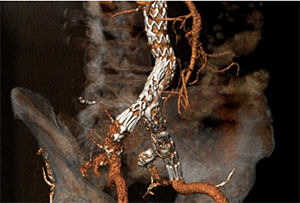Abdominal Aortic Aneurysm Screening: Fighting the Time Bomb in Your Abdomen

Many men carry a ticking time bomb inside them. Their abdominal aorta is dangerously dilated and can rupture at any time. This can pose an acute threat to life, says an expert.
With increasing life expectancy, the number of people developing problems with their aorta is also on the rise. Doctors call the most common and most dangerous complication of this condition an abdominal aortic aneurysm. In this condition, the main blood vessel in the abdomen expands greatly until it threatens to rupture. If this happens, a lot of blood flows into the abdominal cavity within seconds and the affected person often dies before they reach the hospital. “Aneurysms are usually discovered by chance because they initially cause hardly any symptoms,” says Prof. Dr. Martin Czerny, Medical Director of the Department of Cardiovascular Surgery at the University Heart Center Freiburg · Bad Krozingen at the Medical Center - University of Freiburg.
A ten-minute ultrasound scan can save lives
Since 2018, health insurance companies have been paying for a preventive medical check-up for men aged 65 and over. This is because four to eight percent of all men of this age have a dangerous dilation of the blood vessels. During the examination, the doctor uses an ultrasound device to measure the diameter of the abdominal aorta. If it is less than two and a half centimeters, the findings are considered normal. If the aorta is more than three centimeters thick, the patient must be checked every six months with ultrasound. If it is more than five centimeters thick, doctors speak of an aneurysm that requires treatment. The screening can be performed in any practice with an ultrasound machine.
A simple ultrasound scan measures the aorta’s diameter: Below 2,5 cm – normal |
Those affected rarely ever have any symptoms – until it is almost too late
Most of the time, those affected have no symptoms. “This is why it's so important that all men take advantage of the screening,” Prof. Czerny says. It is only when the aorta is on the verge of rupturing that those affected experience pain, usually in the back. In that case, immediate surgery is necessary. “At the Department of Cardiovascular Surgery, which maintains one of the longest-standing and largest aortic centers in Germany, more than 700 procedures are performed on the entire aorta each year.”
Four out of five patients receive minimally invasive care
“The abdominal aorta can be treated with open surgery or minimally invasive surgery. The choice of procedure always depends on the patient and their condition,” Prof. Czerny explains. In the minimally invasive procedure, a wire mesh, known as a stent graft, is advanced through the femoral vessels to the site of the aneurysm under X-ray guidance and expanded there. This is also known as an endovascular procedure. Around 80 percent of all patients with abdominal aortic aneurysms are treated at the University Heart Center using minimally invasive surgery. In acute and particularly complex cases, open surgical intervention is performed.
After surgery is before aftercare: Aortenpass helps
“We firmly believe that follow-up care is just as important as preoperative preparation and treatment,” Prof. Czerny says. This is why all patients treated at the clinic for an aortic aneurysm are regularly examined in the aortic outpatient clinic even after the procedure, and receive an aortic passport. This includes information about the disease, previous procedures, an individual sketch of the aorta, the date of the next check-up, and the contact details of the clinic. According to Prof. Czerny, “This is how we ensure that the time bomb in the abdomen does not start ticking again unnoticed.”
Back